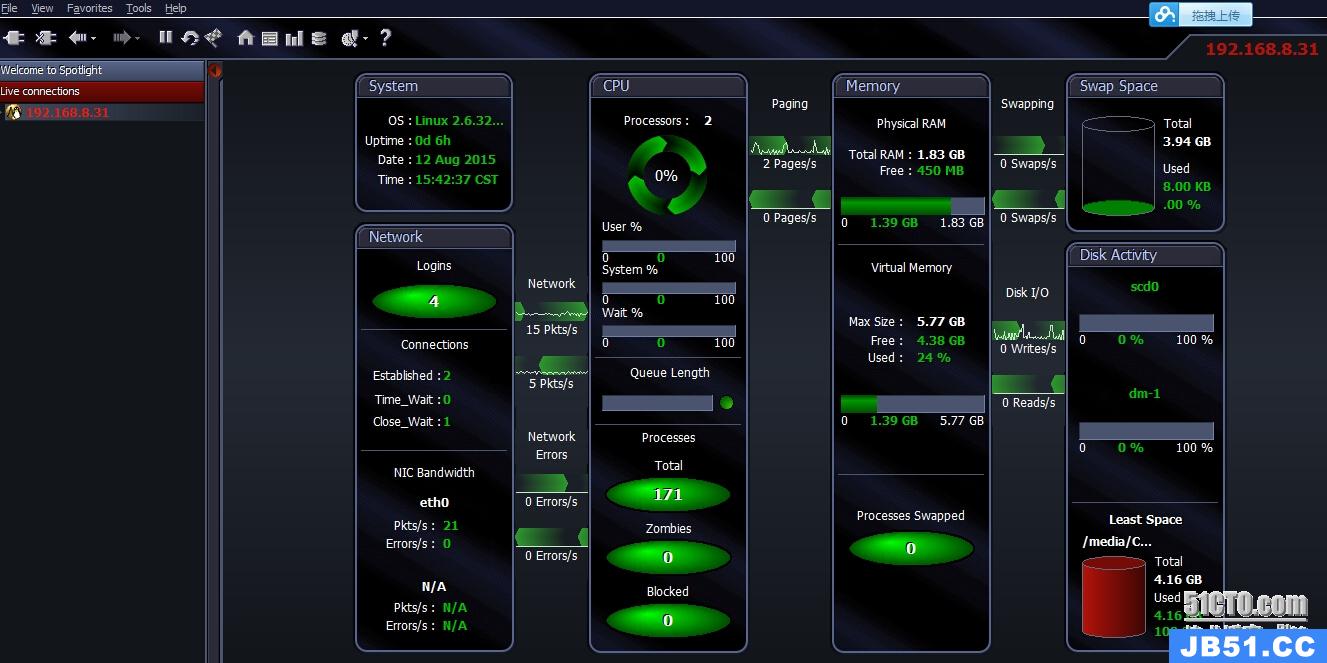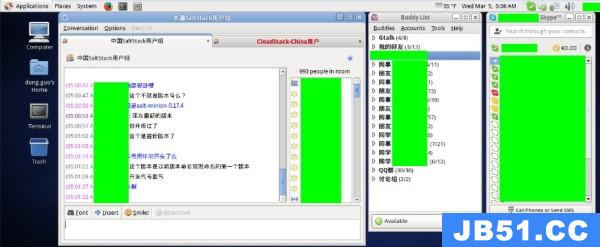工具/原料
-
centos 7.0
-
rsync
-
inotify
第二步: 部署备份服务器inotify-slave
-
这里是部署inotify-slave环境,配置rsync daemon工作方式
1. 检查是否安装rsync
rpm -qa|grep rsync
-
3. 配置rsync的配置文件/etc/rsyncd.conf
# /etc/rsyncd: configuration file for rsync daemon mode
# See rsyncd.conf man page for more options.
# configuration example:
# uid = nobody
# gid = nobody
# use chroot = yes
# max connections = 4
# pid file = /var/run/rsyncd.pid
# exclude = lost+found/
# transfer logging = yes
# timeout = 900
# ignore nonreadable = yes
# dont compress = *.gz *.tgz *.zip *.z *.Z *.rpm *.deb *.bz2
# [ftp]
# path = /home/ftp
# comment = ftp export area
uid = rsync
gid = rsync
#相当于黑洞.出错定位
use chroot = no
#有多少个客户端同时传文件
max connections = 200
#超时时间
timeout = 300
#进程号文件
pid file = /var/run/rsyncd.pid
#日志文件
lock file = /var/run/rsync.lock
#日志文件
log file = /var/log/rsyncd.log
#模块开始
#这个模块对应的是推送目录
#模块名称随便起
[backup]
#需要同步的目录
path = /jhonse/back/
ignore errors
#表示网络权限可写(本地控制真正可写)
read only = false
#这里设置IP或让不让同步
list = false
#指定允许的网段
hosts allow = 192.168.221.0/255
hosts deny = 0.0.0.0/32
#不要动的东西(默认情况)
#虚拟用户
auth users = rsync_backup
secrets file = /etc/rsync.password
-
6.启动rsync服务
rsync --daemon
ps -ef |grep rsync
netstat -lnutp |grep rsync
END
第三步: 部署数据库服务器(inotify-master)
-
说明:inotify是rsync客户端安装和执行的
1.查看当前系统是否支持inotify
ll /proc/sys/fs/inotify/
如果显示max_queued_events、max_user_instances、max_user_watches就证明支持inotify
/proc/sys/fs/inotify/max_queued_evnets
表示调用inotify_init时分配给inotify instance中可排队的event的数目的最大值,超出这个值的事件被丢弃,但会触发IN_Q_OVERFLOW事件。
/proc/sys/fs/inotify/max_user_instances
表示每一个real user ID可创建的inotify instatnces的数量上限。
/proc/sys/fs/inotify/max_user_watches
表示每个inotify instatnces可监控的最大目录数量。如果监控的文件数目巨大,需要根据情况,适当增加此值的大小。
例如: echo 30000000 > /proc/sys/fs/inotify/max_user_watches
-
2.下载inotify源码包并编译安装
wget http://github.com/downloads/rvoicilas/inotify-tools/inotify-tools-3.14.tar.gz #下载inotify源码包
ll inotify-tools-3.14.tar.gz
tar -zxf inotify-tools-3.14.tar.gz
cd inotify-tools-3.14
./configure --prefix=/usr/local/inotify-tools-3.14 #配置inotify,并指定安装路径为/usr/local/inotify-3.14
make && make install
-
3.inotify之inotifywait命令常用参数详解
cd /usr/local/inotify-tools-3.14/
./bin/inotifywait --help
-r|--recursive Watch directories recursively. #递归查询目录
-q|--quiet Print less (only print events). #打印监控事件的信息
-m|--monitor Keep listening for events forever. Without this option,inotifywait will exit after one event is received. #始终保持事件监听状态
--excludei <pattern> Like --exclude but case insensitive. #排除文件或目录时,不区分大小写。
--timefmt <fmt> strftime-compatible format string for use with %T in --format string. #指定时间输出的格式
--format <fmt> Print using a specified printf-like format string; read the man page for more details.
#打印使用指定的输出类似格式字符串
-e|--event <event1> [ -e|--event <event2> ... ] Listen for specific event(s). If omitted,all events are listened for. #通过此参数可以指定需要监控的事件,如下所示:
Events:
access file or directory contents were read #文件或目录被读取。
modify file or directory contents were written #文件或目录内容被修改。
attrib file or directory attributes changed #文件或目录属性被改变。
close file or directory closed,regardless of read/write mode #文件或目录封闭,无论读/写模式。
open file or directory opened #文件或目录被打开。
moved_to file or directory moved to watched directory #文件或目录被移动至另外一个目录。
move file or directory moved to or from watched directory #文件或目录被移动另一个目录或从另一个目录移动至当前目录。
create file or directory created within watched directory #文件或目录被创建在当前目录
delete file or directory deleted within watched directory #文件或目录被删除
unmount file system containing file or directory unmounted #文件系统被卸载
-
4. 参照以上步骤安装rsync
-
5. 创建本地监控目录
mkdir /jhonse
mkdir /jhonse/back
-
7.编写监控脚本并加载到后台执行
vi inotify.sh
#!/bin/bash
#para
host01=192.168.221.136 #inotify-slave的ip地址
src=/jhonse/back #本地监控的目录
dst=backup #inotify-slave的rsync服务的模块名
user=rsync_backup #inotify-slave的rsync服务的虚拟用户
rsync_passfile=/etc/rsync.password #本地调用rsync服务的密码文件
inotify_home=/usr/local/inotify-tools-3.14 #inotify的安装目录
#judge
if [ ! -e "$src" ] \
|| [ ! -e "${rsync_passfile}" ] \
|| [ ! -e "${inotify_home}/bin/inotifywait" ] \
|| [ ! -e "/usr/bin/rsync" ];
then
echo "Check File and Folder"
exit 9
fi
${inotify_home}/bin/inotifywait -mrq --timefmt '%d/%m/%y %H:%M' --format '%T %w%f' -e close_write,delete,create,attrib $src \
| while read file
do
# rsync -avzP --delete --timeout=100 --password-file=${rsync_passfile} $src $user@$host01::$dst >/dev/null 2>&1
cd $src && rsync -aruz -R --delete ./ --timeout=100 $user@$host01::$dst --password-file=${rsync_passfile} >/dev/null 2>&1
done
exit 0
sh inotify.sh &#将脚本加入后台执行
END
第四步: 测试实时同步
-
1. 建议先通过inotify-master测试推送,然后在测试实时同步。
rsync -avz index.txt rsync_backup@192.168.221.136::backup --password-file=/etc/rsync.password
如果出现问题可以查看:/var/log/rsyncd.log日志文件
-
2. 实时同步
END
原文地址:http://jingyan.baidu.com/article/656db918ee2f13e380249c4d.html
版权声明:本文内容由互联网用户自发贡献,该文观点与技术仅代表作者本人。本站仅提供信息存储空间服务,不拥有所有权,不承担相关法律责任。如发现本站有涉嫌侵权/违法违规的内容, 请发送邮件至 dio@foxmail.com 举报,一经查实,本站将立刻删除。







